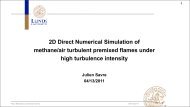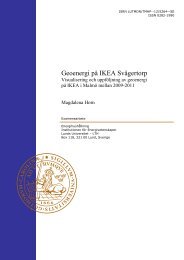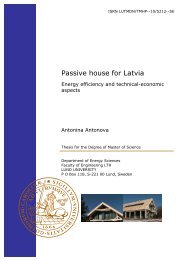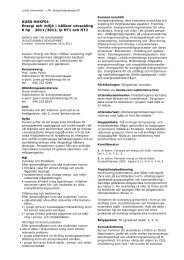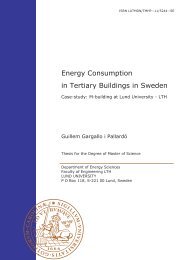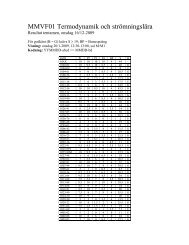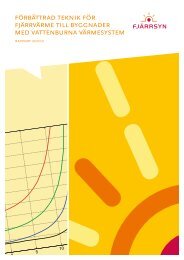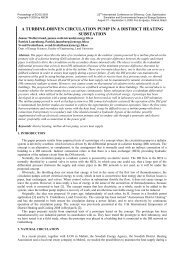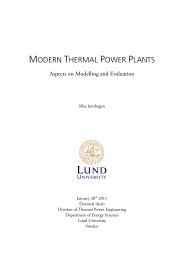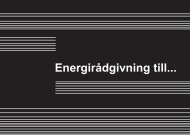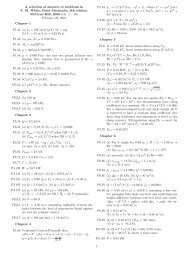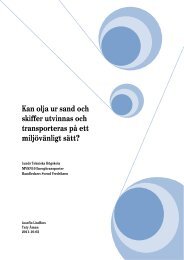Thesis for degree: Licentiate of Engineering
Thesis for degree: Licentiate of Engineering
Thesis for degree: Licentiate of Engineering
Create successful ePaper yourself
Turn your PDF publications into a flip-book with our unique Google optimized e-Paper software.
1 Introduction<br />
After some time <strong>of</strong> decreasing interest, fuel cell research is now receiving a lot <strong>of</strong> attention.<br />
Fuel cells are considered a promising future resource <strong>for</strong> both stationary and distributed<br />
electric power stations because <strong>of</strong> their high per<strong>for</strong>mance and high reliability [1, 2]. In order<br />
to explore these aspects in greater depth, there is a need <strong>for</strong> both multiphysics and multiscale<br />
modeling. The approach is by solving the equations <strong>for</strong> momentum, charge, heat and mass<br />
transport and chemical reactions at the same time at corresponding scales. At this point,<br />
simulation <strong>of</strong> mass diffusion and convection as well as chemical and electrochemical<br />
reactions at microscale will <strong>of</strong>fer crucial insight to improve the per<strong>for</strong>mance <strong>of</strong> the fuel cell<br />
[3]. Furthermore, future prospects <strong>for</strong> fuel cell research are to connect microscale to<br />
macroscale and obtain stable solutions <strong>for</strong> multiscale modeling.<br />
Solid oxide fuel cells (SOFCs) are particularly interesting because it operates at high<br />
temperature and can there<strong>for</strong>e handle the re<strong>for</strong>ming <strong>of</strong> hydrocarbon fuels directly within the<br />
cell. SOFCs have a number <strong>of</strong> advantages, e.g., high conversion efficiency, high quality<br />
exhaust heat and flexibility <strong>of</strong> fuel input. However, as expected, SOFCs also have<br />
disadvantages. For instance, because they operate at very high temperatures (800–1100C<br />
[1]), material per<strong>for</strong>mance and manufacturing costs are currently <strong>of</strong> concern. Recently,<br />
attempts have been made to lower the operating temperature <strong>of</strong> SOFCs by adopting a porous,<br />
anode-supported structure to reduce the thickness <strong>of</strong> the electrolyte.<br />
It is important to model all physical processes and chemical reactions simultaneously since<br />
the mass and charge transport depends on the multifunctional material structure in the porous<br />
electrodes, the chemical reactions, the temperature distribution and the species concentrations.<br />
The fluid flow depends on the chemical reactions, temperature and fluid characteristics. The<br />
heat transport depends on the polarization losses, the chemical reactions, the fluid flow and<br />
the material structure. The re<strong>for</strong>ming reactions depend on temperature, concentration and<br />
amount <strong>of</strong> catalyst available. The interaction issues are numerous and here the microscopic<br />
contributions are important to include. Also it is necessary to model SOFCs into detail and<br />
explore them at a microscopic level, in order to fully understand how different parameters<br />
affect the per<strong>for</strong>mance, by connecting different physical phenomena at different scales [2, 4].<br />
The purpose <strong>of</strong> this study is to develop a microscale model <strong>of</strong> an anode <strong>of</strong> an SOFC <strong>for</strong> the<br />
transport processes and the chemical reactions to get a deeper understanding <strong>of</strong> the effect on<br />
the different physical processes at multiple scales. The lattice Boltzmann method (LBM) is<br />
used to model the mass transport at microscale <strong>for</strong> a limited part <strong>of</strong> the porous anode. Also an<br />
evaluation <strong>of</strong> a macroscale model <strong>for</strong> the whole unit cell is carried out.<br />
1



